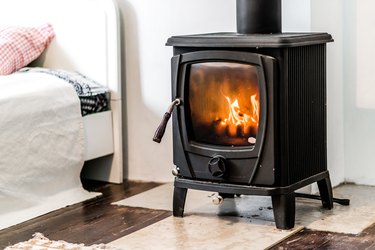
Soot happens when carbon-based materials aren't completely combusted. Fireplaces are common sources of soot on painted walls, especially if the fireplace doesn't have proper airflow or the burners on a gas fireplace are clogged. Keeping your fuel-burning appliances cleaned and well maintained can prevent soot, but you might also need strategies to clean soot off walls if you already have visible black streaks.
Protect Yourself and Your Home
Video of the Day
Soot can be a health hazard in your home, so protect yourself before you start cleaning. Wear a respirator mask so you don't breathe in the soot as you remove it. Choose long sleeves, pants, and shoes to cover as much skin as possible. Wearing gloves and goggles also protects you from the soot.
Video of the Day
Open a window if possible to ventilate the space. Place newspaper or plastic sheeting on the floor below the area you're cleaning to protect your flooring. You might also need to move or cover your furniture to protect it from soot while you clean.
Vacuum the Walls
Before using any type of cleaner, grab your vacuum to suck up as much soot as possible. When you clean soot off walls with a vacuum, hold the vacuum hose close to the wall without touching it. If you rub the vacuum attachment against the soot, you can spread it or damage the wall. Vacuuming won't remove all of the soot, but it will remove some of the particles as well as other dirt and debris on the wall to make additional cleaning methods more effective.
Use a Soot Sponge
Start with dry cleaning methods to remove the soot without damaging the wall. A soot sponge is an effective method for dry cleaning your walls. Starting from the top of the painted wall, work downward using the sponge to wipe off the soot. As the sponge becomes covered with soot, rinse it and let it dry to reuse it or grab a fresh sponge. You can continue wiping the sooty areas with a dry soot sponge until it's all gone, but the sponge might not remove all of the soot.
Try Wet Cleaning Methods
Another option for cleaning walls with soot on them is wet cleaning. This option is usually best for any soot that remains after you try dry cleaning methods. Water and cleaner can drip down the wall and spread the soot stains, so apply it carefully to avoid running. You can use a commercial soot remover for walls, dish soap, or degreaser to clean the walls. Follow the instructions for diluting if you use a degreaser or commercial product or add a few drops of dish soap to warm water. Test out the cleaner you choose on a hidden part of the wall first to make sure it doesn't discolor or ruin the paint.
Use a microfiber cloth or sponge to apply the cleaner to the sooty area. Wring out the extra water before cleaning the wall. Scrub gently to protect the painted surface and rinse the sponge or cloth frequently to avoid spreading around the soot. Wipe down the walls with clean water and dry them when you've removed all of the soot.
Repaint the Walls
If these cleaning options don't remove all of the black marks, you might decide to repaint the soot-covered walls to hide the stains. Choose a primer that will cover the stains well before painting the walls. Correcting the issue that caused the soot buildup should also be a priority so you don't waste your time painting walls that will be quickly stained again.